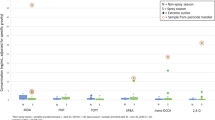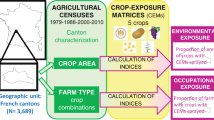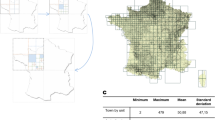Abstract
Background
Farmworkers in the United States, especially migrant workers, face unique barriers to healthcare and have documented disparities in health outcomes. Exposure to pesticides, especially those persistent in the environment, may contribute to these health disparities.
Objective
Quantify differences in pesticide exposure bioactivity by farmworker category and US citizenship status.
Methods
We queried the National Health and Nutrition Examination Study (NHANES) from 1999-2014 for pesticide exposure biomarker concentrations among farmworkers and non-farmworkers by citizenship status. We combined this with toxicity assay data from the US Environmental Protection Agency’s (EPA’s) Toxicity Forecaster (ToxCast). We estimated adverse biological effects that occur across a range of human population-relevant pesticide doses.
Results
In total, there were 844 people with any farmwork history and 23,592 non-farmworkers. Of 12 commonly detectable pesticide biomarkers in NHANES, 2,4-dichlorophenoxyacetic acid (OR = 3.76, p = 1.33 × 10−6) was significantly higher in farmworkers than non-farmworkers. Farmworkers were 1.15 times more likely to have a bioactive pesticide biomarker measurement in comparison to non-farmworkers (adjusted OR = 1.15, 95% CI: 0.87, 1.51). Non-U.S. citizens were 1.39 times more likely to have bioactive pesticide biomarker concentrations compared to people with U.S. citizenship (adjusted OR 1.39, 95% CI: 1.17, 1.64). Additionally, non-citizens were significantly more exposed to bioactive levels of β-hexachlorocyclohexane (BHC) (OR = 8.10, p = 1.33 × 10−6), p,p-DDE (OR = 2.60, p = 0.02), and p,p’-DDT (OR = 7.75, p = 0.01).
Impact statement
Farmworkers are a vulnerable population due to social determinants of health and occupational exposures. Here, we integrate US population chemical biomonitoring data and toxicity outcome data to assess pesticide exposure by farmwork history and citizenship. We find that farmworkers and those without US citizenship are significantly more likely to be exposed to concentrations of pesticides which are bioactive in toxicological assays. Thus, farmworkers employed in the US but who are not citizens could be at increased risk of harm to their health due to pesticides. These findings are important to shape evidence-based policies in regulatory science to promote worker safety.
This is a preview of subscription content, access via your institution
Access options
Subscribe to this journal
Receive 6 print issues and online access
$259.00 per year
only $43.17 per issue
Buy this article
- Purchase on Springer Link
- Instant access to full article PDF
Prices may be subject to local taxes which are calculated during checkout


Similar content being viewed by others
Data availability
The NHANES and ToxCast datasets analyzed during the current study are available from the CDC, https://wwwn.cdc.gov/nchs/nhanes/, and the EPA, https://www.epa.gov/chemical-research/exploring-toxcast-data.
References
Wei Y, Zhu J, Nguyen A. Urinary concentrations of dichlorophenol pesticides and obesity among adult participants in the U.S. National Health and Nutrition Examination Survey (NHANES) 2005–2008. Int J Hyg Environ Health. 2014;217:294–9.
Zong G, Valvi D, Coull B, Göen T, Hu FB, Nielsen F, et al. Persistent organic pollutants and risk of type 2 diabetes: a prospective investigation among middle-aged women in Nurses’ Health Study II. Environ Int. 2018;114:334–42.
Medehouenou TCM, Ayotte P, Carmichael PH, Kröger E, Verreault R, Lindsay J, et al. Exposure to polychlorinated biphenyls and organochlorine pesticides and risk of dementia, Alzheimer’s disease and cognitive decline in an older population: a prospective analysis from the Canadian Study of Health and Aging. Environ Health. 2019;18:57.
Martyniuk CJ, Mehinto AC, Denslow ND. Organochlorine pesticides: agrochemicals with potent endocrine-disrupting properties in fish. Mol Cell Endocrinol. 2020;507:110764.
Briz V, Molina-Molina JM, Sánchez-Redondo S, Fernández MF, Grimalt JO, Olea N, et al. Differential estrogenic effects of the persistent organochlorine pesticides dieldrin, endosulfan, and lindane in primary neuronal cultures. Toxicol Sci. 2011;120:413–27.
Wong HL, Garthwaite DG, Ramwell CT, Brown CD. Assessment of occupational exposure to pesticide mixtures with endocrine-disrupting activity. Environ Sci Pollut Res. 2019;26:1642–53.
Abubakar Y, Tijjani H, Egbuna C, Adetunji CO, Kala S, Kryeziu TL, et al. Chapter 3 - Pesticides, History, and Classification. In: Egbuna C, Sawicka B, editors. Natural remedies for pest, disease and weed control. Cambridge, Massachusetts: Academic Press; 2020. p. 29–42.
Mostafalou S, Abdollahi M. Pesticides and human chronic diseases: evidences, mechanisms, and perspectives. Toxicol Appl Pharm. 2013;268:157–77.
Dhananjayan V, Ravichandran B. Occupational health risk of farmers exposed to pesticides in agricultural activities. Curr Opin Environ Sci Health. 2018;4:31–7.
Jaga K, Dharmani C. Sources of exposure to and public health implications of organophosphate pesticides. Rev Panam Salud Pública. 2003;14:171–85.
Das R, Steege A, Baron S, Beckman J, Harrison R. Pesticide-related illness among migrant farm workers in the United States. Int J Occup Environ Health. 2001;7:303–12.
García-García CR, Parrón T, Requena M, Alarcón R, Tsatsakis AM, Hernández AF. Occupational pesticide exposure and adverse health effects at the clinical, hematological and biochemical level. Life Sci. 2016;145:274–83.
Holmes SM. An ethnographic study of the social context of migrant health in the United States. Gill P, editor. PLoS Med. 2006;3:e448.
Wallace SP, Rodriguez M, Padilla-Frausto I, Arredondo A, Orozco E. Improving access to health care for undocumented immigrants in the United States. Salud Pública México. 2013;55:508.
Hall E, Cuellar NG. Immigrant health in the United States: a trajectory toward change. J Transcult Nurs. 2016;27:611–26.
Bustamante AV, Chen J, Félix Beltrán L, Ortega AN. Health policy challenges posed by shifting demographics and health trends among immigrants to the United States. Health Aff. 2021;40:1028–37.
Arcury TA, Quandt SA. Delivery of health services to migrant and seasonal farmworkers. Annu Rev Public Health. 2007;28:345–63.
Quesada J, Hart LK, Bourgois P. Structural vulnerability and health: latino migrant laborers in the United States. Med Anthropol. 2011;30:339–62.
Barnes N. Is health a labour, citizenship or human right? Mexican seasonal agricultural workers in Leamington, Canada. Glob Public Health. 2013;8:654–69.
Ramos A, Carlo G, Grant K, Trinidad N, Correa A. Stress, depression, and occupational injury among migrant farmworkers in Nebraska. Safety. 2016;2:23.
Ramos AK. A human rights-based approach to farmworker health: an overarching framework to address the social determinants of health. J Agromedicine. 2018;23:25–31.
Saxton DI, Stuesse A. Workers’ decompensation: engaged research with injured im/migrant workers: anthropology of work review. Anthropol Work Rev. 2018;39:65–78.
Ramos AK, Su D, Lander L, Rivera R. Stress factors contributing to depression among latino migrant farmworkers in Nebraska. J Immigr Minor Health. 2015;17:1627–34.
Attene-Ramos MS, Miller N, Huang R, Michael S, Itkin M, Kavlock RJ, et al. The Tox21 robotic platform for the assessment of environmental chemicals – from vision to reality. Drug Discov Today. 2013;18:716–23.
Adeola FO. Global impact of chemicals and toxic substances on human health and the environment. In: Kickbusch I, Ganten D, Moeti M, editors. Handbook of Global Health. Cham: Springer International Publishing; 2021. p. 2227–56. https://link.springer.com/10.1007/978-3-030-45009-0.
Thomas R, Paules RS, Simeonov A, Fitzpatrick SC, Crofton KM, Casey WM, et al. The US Federal Tox21 Program: a strategic and operational plan for continued leadership. ALTEX. 2018;35:163–8.
Centers for Disease Control and Prevention. National Health and Nutrition Examination Survey Data. National Center for Health Statistics. 2023. https://www.cdc.gov/nchs/nhanes/index.htm.
Curtin LR, Mohadjer LK, Dohrmann SM, Montaquila JM, Kruszan-Moran D, Mirel LB, et al. National health and nutrition examination survey: sample design,1999-2006. Vital- Health Stat 2. 2012;155:1–39.
Calafat AM. The U.S. National Health and Nutrition Examination Survey and human exposure to environmental chemicals. Int J Hyg Environ Health. 2012;215:99–101.
Barr DB, Wilder LC, Caudill SP, Gonzalez AJ, Needham LL, Pirkle JL. Urinary creatinine concentrations in the U.S. population: implications for urinary biologic monitoring measurements. Environ Health Perspect. 2005;113:192–200.
U.S. Environmental Protection Agency. Toxicity Forecasting. Safer Chemicals Research | US EPA. 2023. https://www.epa.gov/chemical-research/toxicity-forecasting.
Filer DL, Kothiya P, Setzer RW, Judson RS, Martin MT. tcpl: the ToxCast pipeline for high-throughput screening data. Bioinformatica. 2017;33:618–20.
Blackwell BR, Ankley GT, Corsi SR, DeCicco LA, Houck KA, Judson RS, et al. An “EAR” on environmental surveillance and monitoring: a case study on the use of exposure–activity ratios (EARs) to prioritize sites, chemicals, and bioactivities of concern in Great Lakes Waters. Environ Sci Technol. 2017;51:8713–24.
Putzrath RM. Estimating relative potency for receptor-mediated toxicity: reevaluating the toxicity equivalence factor (TEF) model. Regul Toxicol Pharm. 1997;25:68–78.
Silver MK, Arain AL, Shao J, Chen M, Xia Y, Lozoff B, et al. Distribution and predictors of 20 toxic and essential metals in the umbilical cord blood of Chinese newborns. Chemosphere. 2018;210:1167–75.
Millar JA, Forté CA. ColacinoLab/Farmwork_Citizenship_Pesticides: code and data used to to compare pesticide exposure and bioactivity by farmwork history and US citizenship. GitHub; 2023. https://github.com/ColacinoLab/Farmwork_Citizenship_Pesticides.
Wickham H. ggplot2: Elegant graphics for data analysis. 3rd ed. Cham: Springer International Publishing; 2016. http://link.springer.com/10.1007/978-3-319-24277-4.
Susmann H. Package “RNHANES”: facilitates analysis of CDC NHANES data. The Comprehensive R Archive Network; 2016. https://cran.r-project.org/web/packages/RNHANES/RNHANES.pdf.
U.S. Environmental Protection Agency. ToxCast & Tox21 summary files from invitrodb_v3. Safer Chemicals Research | US EPA; 2020. https://www.epa.gov/chemical-research/exploring-toxcast-data.
Sniegoski LT, Moody JR. Determination of serum and blood densities. Anal Chem. 1979;51:1577–8.
Hocking TD. Package “WeightedROC”: fast, weighted ROC curves. The Comprehensive R Archive Network; 2020. https://cran.r-project.org/web/packages/WeightedROC/WeightedROC.pdf.
Mason SJ, Graham NE. Areas beneath the relative operating characteristics (ROC) and relative operating levels (ROL) curves: statistical significance and interpretation. Q J R Meteorol Soc. 2002;128:2145–66.
Pérez-Maldonado IN, Trejo A, Ruepert C, Jovel RDC, Méndez MP, Ferrari M, et al. Assessment of DDT levels in selected environmental media and biological samples from Mexico and Central America. Chemosphere. 2010;78:1244–9.
Li BA. Dichloro-diphenyl-trichloroethane (DDT): an unforgettable and powerful pesticide. J High Sch Sci. 2022;6. https://www.excli.de/vol17/Lushchak_08112018_proof.pdf.
Gibson JC, Marro L, Brandow D, Remedios L, Fisher M, Borghese MM, et al. Biomonitoring of DEET and DCBA in Canadian children following typical protective insect repellent use. Int J Hyg Environ Health. 2023;248:114093.
Mills PK, Beaumont JJ, Nasseri K. Proportionate mortality among current and former members of the United Farm Workers of America, AFL-CIO, in California 1973-2000. J Agromedicine. 2006;11:39–48.
Fry K, Power MC. Persistent organic pollutants and mortality in the United States, NHANES 1999–2011. Environ Health. 2017;16:105.
Cohn BA, La Merrill M, Krigbaum NY, Yeh G, Park JS, Zimmermann L, et al. DDT exposure in utero and breast cancer. J Clin Endocrinol Metab. 2015;100:2865–72.
Guadamuz JS, Durazo-Arvizu RA, Daviglus ML, Calip GS, Nutescu EA, Qato DM. Citizenship status and the prevalence, treatment, and control of cardiovascular disease risk factors among adults in the United States, 2011–2016. Circ Cardiovasc Qual Outcomes. 2020;13:e006215.
Chasens ER, Dinardo M, Imes CC, Morris JL, Braxter B, Yang K. Citizenship and health insurance status predict glycemic management: NHANES data 2007–2016. Prev Med. 2020;139:106180.
Acknowledgements
Authors have no acknowledgements to address in this section.
Funding
The researchers included on this study were supported by the National Institute of Occupational Safety and Health Education Research Center (Grant# T42 OH 008455), the National Institute of Environmental Health Sciences Environmental Toxicology and Epidemiology Program (Grant# T32 ES007062), the National Science Foundation Graduate Research Program (Grant # DGE-1256260), and the National Institutes of Health (R01 ES028802, P30 ES017885, R01AG072396).
Author information
Authors and Affiliations
Contributions
JC and CF contributed to the study conception and design. Material preparation and data collection were performed by CF. Analysis was performed by JM and CF. The first draft of the manuscript was written by CF and all authors commented on subsequent versions of the manuscript. All authors read and approved the final manuscript.
Corresponding author
Ethics declarations
Competing interests
The authors declare no competing interests.
Additional information
Publisher’s note Springer Nature remains neutral with regard to jurisdictional claims in published maps and institutional affiliations.
Supplementary information
Rights and permissions
Springer Nature or its licensor (e.g. a society or other partner) holds exclusive rights to this article under a publishing agreement with the author(s) or other rightsholder(s); author self-archiving of the accepted manuscript version of this article is solely governed by the terms of such publishing agreement and applicable law.
About this article
Cite this article
Forté, C.A., Millar, J.A. & Colacino, J.A. Integrating NHANES and toxicity forecaster data to compare pesticide exposure and bioactivity by farmwork history and US citizenship. J Expo Sci Environ Epidemiol (2023). https://doi.org/10.1038/s41370-023-00583-5
Received:
Revised:
Accepted:
Published:
DOI: https://doi.org/10.1038/s41370-023-00583-5



